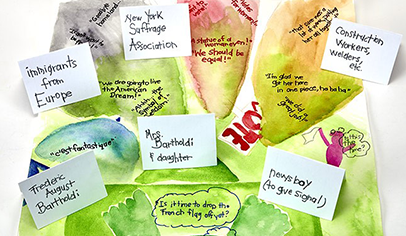Learning area: Social-Emotional Competence, History, Social Studies, Art, Language Arts
Time commitment: Two or three 40-minute periods
Best for: Grade 3, Grade 4, Grade 5, Grade 6

Students consider leadership roles involved in their school and community. They research organizations’ goals and leaders’ accomplishments. They collaboratively create art that documents what they learned.
Materials:
- Crayola Colored Pencils
- Crayola Colors of the World™ Markers
- Crayola Watercolors
- Crayola Paint Brushes
- Crayola Scissors
- Crayola Glue
- Paper
- Water and Paper Towels
Instructions:
CONNECT. Facilitate a student discussion on:
- Types of organizations that exist or are needed in your community.
- Examples of leadership and advocacy roles demonstrated by those organizations as they meet people’s needs, solve problems, communicate ideas, bring together collaborators, and so on.
- The characteristics or qualities of leaders and identifying traits that exemplify leadership characteristics in members of the class and school.
CREATE. Students will:
- Collaboratively create art that demonstrates organizational leadership and personal leadership seen in your community and classroom.
- Use watercolors to create a background on a large, sturdy piece of paper. Practice watercolor wash techniques by adding color to the wet paper. Let different colors overlap and blend to create a textured visual effect. Leave some white spaces. As the base dries, form three-dimensional shapes to represent organizations from the CONNECT discussion.
- Write statements that describe the organizations’ roles and contributions as well as the leadership qualities needed to accomplish this work. When dry, glue the shapes to the background.
PRESENT. Ask students to:
- Present their visual representation and their description of leadership characteristics that contribute to the community.
- Ask questions and listen to others’ feedback. Embrace inquiry and different points of view during the presentation.
RESPOND. Students will:
- Answer others’ questions by sharing additional ideas and demonstrating that leaders are open to multiple perspectives.
- Use this project as a springboard for leadership roles they can create and undertake in the school or community such as forming a kindness club, helping younger students navigate learning struggles, organizing a school or community garden, or creating posters to communicate health reminders.
Learn More:
- If this activity is done remotely, give families tips for how to display the artwork at home and how to discuss leadership roles in ways that are respectful and acknowledge individual differences.
- Leadership is embedded in 21st century learning skills. See Learning in the 21st Century and Simple Ways to Promote Student Voice in the Classroom
- Building Creative Capacity Transforms Schools: Practical tips for getting started, by Kelly Schofield, at PrincipalCrayola_SeptOct17_smallsp.pdf
- Crayola offers lessons, projects, webinars, and other support at https://www.crayola.com/education
- There are many frameworks for social-emotional learning. CASEL Social Emotional Competencies are at https://casel.org/sel-framework/




